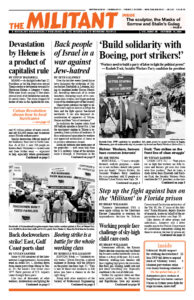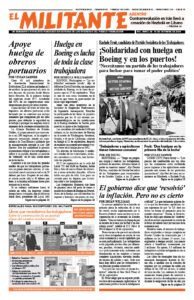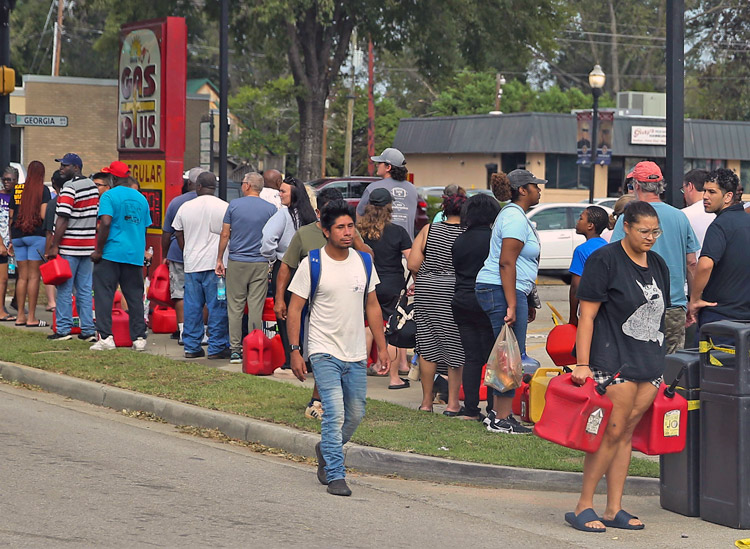MIAMI — As daylight broke Sept. 27, Floridians in the Big Bend area around Tampa awoke to devastation wrought by Hurricane Helene, a Category 4 storm. With water levels surging 15 feet above ground level, it hit Steinhatchee and other coastal towns. The storm dropped 16 inches of rain in the Apalachicola area, and 40 trillion gallons of water overall, and left 838,000 homes and businesses across Florida without power.
Similar destruction affected much of the Southeast, from here to North Carolina. As of Oct. 1, over 150 people are known dead. Volunteers — in each area and from farther away — organized to help, especially where governments were unprepared and slow to respond, including veterans of the Cajun Navy from Louisiana.
The full extent of the catastrophe won’t be known for some time, but, as always, working people were hit the hardest.
“Helene’s timing wouldn’t be good anytime, but now is awful,” wrote Brad Haire in the Southeast Farm Press, describing the serious predicament facing farmers.
Going into the storm, an estimated 65% to 75% of the region’s cotton bolls were open and exposed. Farmers rushed to try to pick what they could, but under 10% had been harvested, he said. Before the storm, the crop looked promising, now it looks like a near total loss.
“The farmer loses all costs up to harvest and may even lose harvesting, packing and marketing costs,” Karl Butts, a vegetable farmer in Plant City, Florida, near Tampa, an area hard hit, told the Militant.
“Many crops are all vulnerable to flood and high wind conditions and row crops at harvest stage have full canopies and fruit load and are susceptible to damage making them impossible to harvest,” he said. “Mature fields that are under flooded conditions for 24 to 48 hours are toast.”
“It’s easy to understate the actual impact on farmers, including destruction and damage to equipment, out-buildings, homes, loss of power to coolers, washing out of farm roads, furrowing out fields and water control structures. It’s a lot more than just lost income,” Butts explained.
“With the high costs of production, a farmer must have everything go right to make anything. But Helene isn’t just about losing a crop, it’s about losing everything.”
Steinhatchee, North Miami
Amid the devastation in the town of Steinhatchee in Taylor County, the Palm Beach Post reported how Crystal Mroz, manager of Maddie’s Market, a local convenience store, came to the aid of her neighbors. As she and a half dozen others opened the shop’s doors after the storm, they saw a shambles of potato chips, beer cans, cans of food and coffee that had spilled from the shelves. Mud covered the floor.
People were largely left on their own to cope with the disaster. Working-class solidarity was crucial.
“It’s free for all — take everything,” Mroz told people in the storm-ravaged community. “Anything and everything is yours. Just be careful walking around, please.”
In the heavily wooded, working-class area of North Miami, even the relatively modest tropical-storm-force winds and rain were enough to cause life-changing damage to residents.
Johnny Ramirez, a truck driver, stepped outside his rented three-room bungalow to find a 75-foot-tall tree felled across his driveway and into part of the street.
“I told the landlord that the tree had to be trimmed, but he paid no attention. It took a hurricane for the whole neighborhood to see it was rotten and termite infested.”
The landlord cut the tree but left the trunk and branches for Ramirez and his neighbors to contend with. They worked together to help each other.
“Lucky thing for us that a neighbor has a truck,” Ramirez told the Militant. “He and his sons went around with a chain saw taking care of the damaged trees and hauling them off to the city incinerator. We would have had all kinds of problems if they didn’t show up to help.”
North Carolina hardest hit
One of the hardest-hit areas in the region was the western hill country in North Carolina. In Asheville, “the ground disappeared on South Tunnel Road, leaving a giant sinkhole full of asphalt soup, the Asheville Citizen-Times reported. “Houses floated away. Bridges crumbled.
“The flood waters flipped semi-trucks into mangled piles.” Water supplies, electricity, wifi and cell service were cut off.
“At the beginning it was all fun and games, just watching the water be where it was,” Syd Yatteau in nearby Swannanoa told the paper. “And then it just kept going up.”
Roads were cut off. In Swannanoa, helicopters were used to drop food from overhead to a church and a Harley-Davidson shop for distribution.
People gathered wherever they could find a signal to use their phones to contact others. They wanted to let friends and relatives know they were OK, and to try and reach others to find out how they were. They would say, “Are you OK? Do you have food? Can I help you?”
With banks closed and electricity down, meaning no access to ATM machines, many were running out of money. People who could would cook food and give it away. Jason Razillard handed out baked goods and coffee from the back of his van near the Riverlink Bridge overlooking the flooded River Arts District.
The city’s water supply infrastructure is badly damaged. People here say they’re looking at weeks or months before it can return to service.


